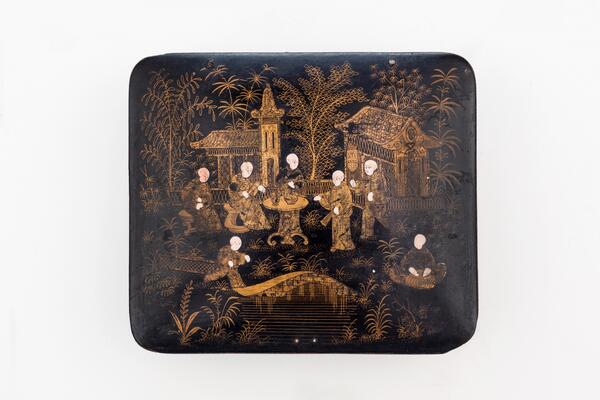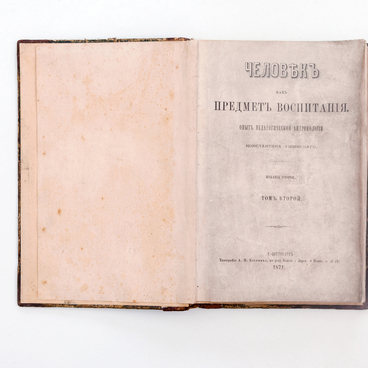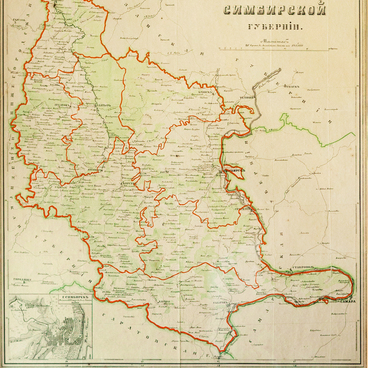The black lacquered Chinese box is in the bedroom of Anna, the sister of Vladimir Ulyanov. As the eldest daughter and a gymnasium student, she had a separate room in the house, as did her brothers Sasha and Volodya.
The box was made of papier-mache, a mixture of shredded wet paper and cardboard fibers with adhesives such as starch paste, plaster, and others. The hinged lid and metal loops and the ends are painted in gold. The artist portrayed in detail everyday scenes from the life of the Chinese.
The papier-mache technique originated in China. During the excavations in this country, archaeologists found ancient armor and helmets made of papier-mache, for rigidity covered by several layers of varnish. This armor could withstand an arrow or a sword blow. Scientists have dated them very roughly: from 202 BC to 220 AD.
From China, papier-mache came to Japan, then to the Middle East and from there to Europe. In the middle of the 17th century in France, and then in England dolls made of this material became popular. In Russia, this technique came during the reign of Peter I. In the 18th century, papier-mâché was used to produce boxes, snuff boxes, chests, and cigarette cases.
Workpieces were made in the following way: sheets of paper or cardboard were cut to ribbons of the same width and put together. The layers were smeared with paste and rolled on cylinders, then the resulting coil was placed under the press of several tons. After that the saturated papier-mache was dried, soaked with linseed oil and kept in drying cabinets for several days. Papier-mache would darken and become as strong as wood.
In the village of Fedoskino, for the first time, papier-mâché boxes were varnished and painted with miniatures. Such painting was called Lukutin lacquer — after the name of the owner of the factory for the production of household items made of papier-mache, Peter Lukutin.
The lacquer coating of the boxes remained hard and flexible after drying, did not react to hot water and did not smell. It did not harbor wood bugs or mold fungus. Lacquer was cheap, hygienic and functional — it could be painted, cut, applied to any surface, flat or shaped, on wood, papier-mache, simply on paper.
Altogether four schools of lacquer miniature were formed in Russia: Palekh, Mstyora, Kholui and Fedoskino. This is the only manner of Russian traditional painting that is not related to icon painting.
The box was made of papier-mache, a mixture of shredded wet paper and cardboard fibers with adhesives such as starch paste, plaster, and others. The hinged lid and metal loops and the ends are painted in gold. The artist portrayed in detail everyday scenes from the life of the Chinese.
The papier-mache technique originated in China. During the excavations in this country, archaeologists found ancient armor and helmets made of papier-mache, for rigidity covered by several layers of varnish. This armor could withstand an arrow or a sword blow. Scientists have dated them very roughly: from 202 BC to 220 AD.
From China, papier-mache came to Japan, then to the Middle East and from there to Europe. In the middle of the 17th century in France, and then in England dolls made of this material became popular. In Russia, this technique came during the reign of Peter I. In the 18th century, papier-mâché was used to produce boxes, snuff boxes, chests, and cigarette cases.
Workpieces were made in the following way: sheets of paper or cardboard were cut to ribbons of the same width and put together. The layers were smeared with paste and rolled on cylinders, then the resulting coil was placed under the press of several tons. After that the saturated papier-mache was dried, soaked with linseed oil and kept in drying cabinets for several days. Papier-mache would darken and become as strong as wood.
In the village of Fedoskino, for the first time, papier-mâché boxes were varnished and painted with miniatures. Such painting was called Lukutin lacquer — after the name of the owner of the factory for the production of household items made of papier-mache, Peter Lukutin.
The lacquer coating of the boxes remained hard and flexible after drying, did not react to hot water and did not smell. It did not harbor wood bugs or mold fungus. Lacquer was cheap, hygienic and functional — it could be painted, cut, applied to any surface, flat or shaped, on wood, papier-mache, simply on paper.
Altogether four schools of lacquer miniature were formed in Russia: Palekh, Mstyora, Kholui and Fedoskino. This is the only manner of Russian traditional painting that is not related to icon painting.



